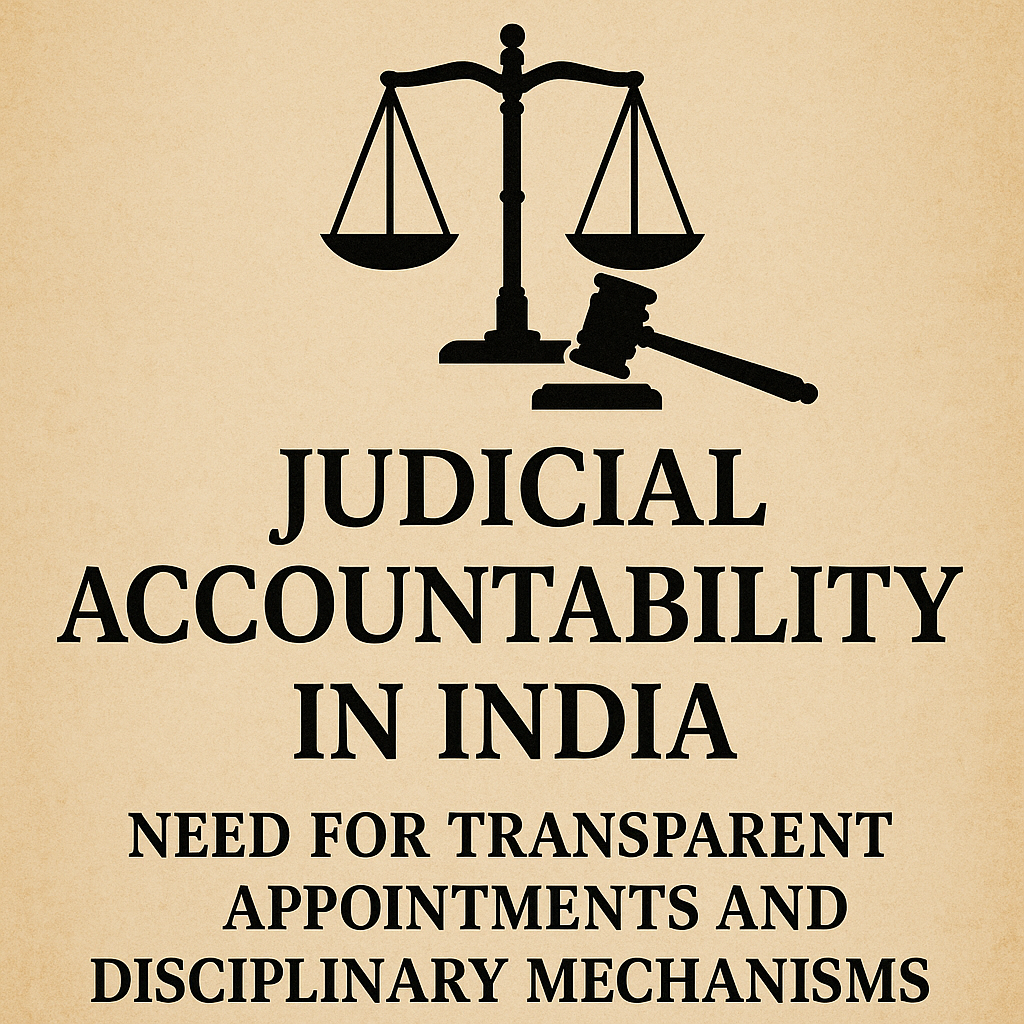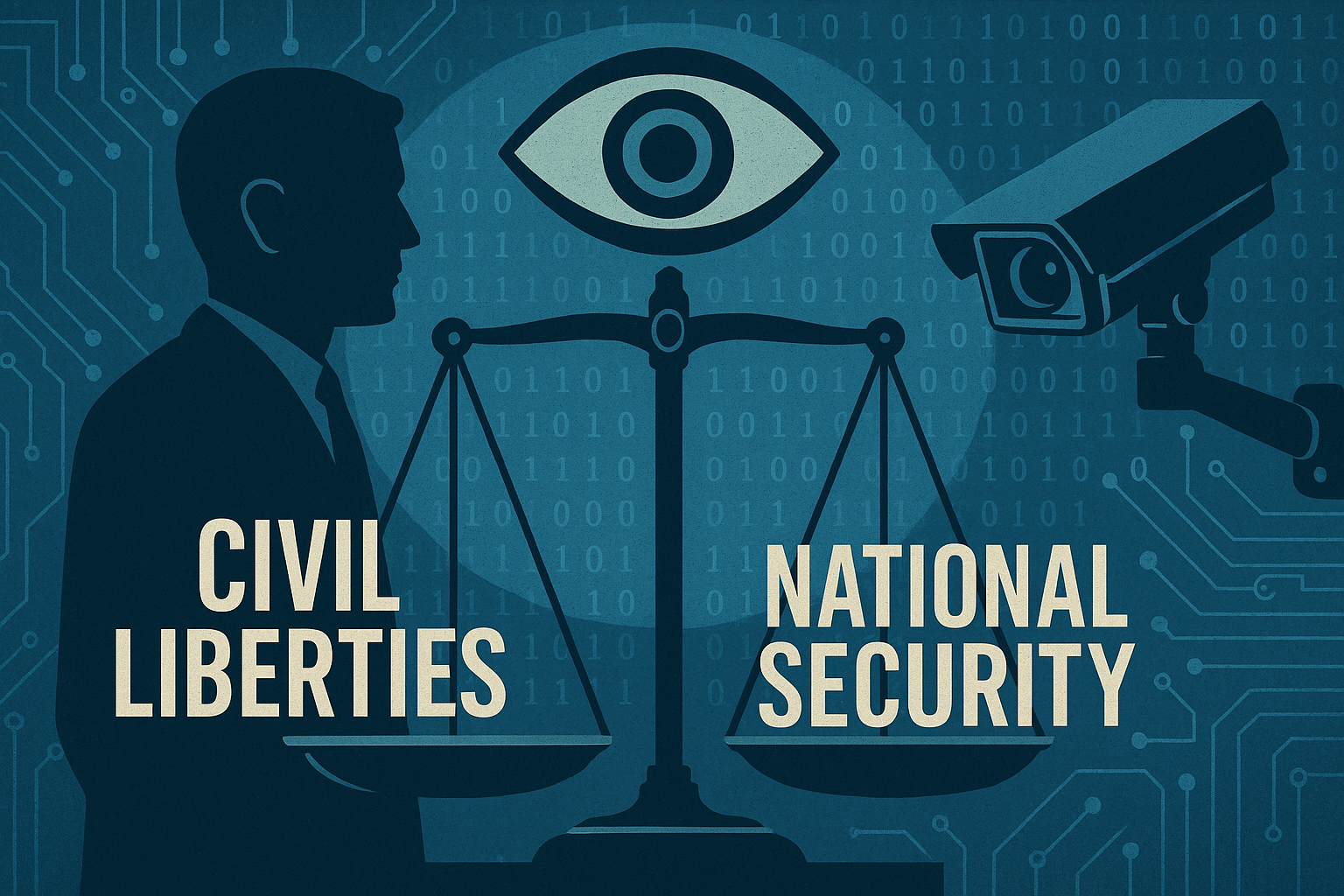Judicial Accountability in India: Need for Transparent Appointments and Disciplinary Mechanisms
I. Introduction
The judiciary in India, one of the three foundational pillars of the state, serves not just as an interpreter of law but as the guardian of the Constitution, the protector of rights, and the final arbiter in disputes between citizens, and between the state and its people. However, with great power comes great responsibility — and in a democratic society governed by the rule of law, judicial independence must be matched by robust judicial accountability.
While India’s judiciary has earned acclaim for landmark decisions on constitutional rights, electoral reforms, and public interest litigation, it has simultaneously faced criticism for opaqueness in its internal functioning — especially in the domains of appointments and disciplinary actions. Increasing delays in justice delivery, selective listing of cases, judicial misconduct, and lack of transparency in appointments have triggered debates on the need for systemic reforms.
In this context, the issue of judicial accountability is not just a matter of administrative reform — it is crucial for safeguarding democracy, institutional credibility, and the rule of law. This article provides a deep exploration of the shortcomings in current appointment and disciplinary systems in the Indian judiciary, evaluates comparative international models, and suggests comprehensive reforms.
II. Constitutional Framework and Judicial Independence
Judicial independence is enshrined in the Indian Constitution through multiple provisions — notably:
- Article 124 and Article 217: Appointment of Supreme Court and High Court judges.
- Article 50: Separation of judiciary from the executive.
- Article 121 and 211: Prohibit parliamentary discussion on the conduct of judges.
- Articles 124(4) and 217(1)(b): Provide for the removal of judges only through an impeachment process.
These provisions aim to insulate judges from political influence. However, independence is often misconstrued as immunity from scrutiny. As Chief Justice J.S. Verma once noted, “Judicial independence is not a shield for judicial accountability.” Without transparency, independence can become a veil behind which nepotism, corruption, or inefficiency may thrive unchecked.
III. The Judicial Appointments System: The Crisis of Transparency
1. The Collegium System
The current appointments process is governed by the Collegium System, created by the Supreme Court through judicial decisions in:
- First Judges Case (1981) – upheld executive primacy in appointments.
- Second Judges Case (1993) – introduced judicial primacy via Collegium.
- Third Judges Case (1998) – clarified that the Chief Justice must consult a collegium of four senior judges.
Under this system, the judiciary essentially appoints itself, particularly in higher courts — a practice unique to India.
2. Problems in the Collegium System
- Lack of Transparency: The selection criteria for judges are not disclosed. Collegium resolutions were only recently made public and often without complete rationale.
- No Accountability Mechanism: There is no oversight or challenge mechanism to decisions.
- Exclusionary Nature: Critics argue that the system fosters nepotism, regionalism, and favoritism, excluding deserving candidates from diverse backgrounds.
- No Public Participation: Civil society and Bar Associations have no say in appointments.
- Lack of Diversity: Marginalized communities, women, and first-generation lawyers remain grossly underrepresented.
IV. The NJAC Debacle: A Lost Opportunity or Constitutional Safeguard?
To address the flaws in the collegium, Parliament unanimously passed the National Judicial Appointments Commission (NJAC) Act and the 99th Constitutional Amendment in 2014. The NJAC included members from the judiciary, executive, and civil society.
However, in 2015, the Supreme Court struck it down in the Fourth Judges Case, holding it unconstitutional for compromising judicial independence.
Key Arguments Against NJAC:
- Judicial primacy would be diluted by political interference.
- Inclusion of the Law Minister raised fears of executive control.
Critics of the Verdict Argue:
- The judgment reinforced judicial monopoly and ignored legitimate public concerns.
- A collaborative appointment process with checks and balances could have enhanced legitimacy.
The striking down of NJAC reinstated the Collegium, but without meaningful reforms to address its core flaws.
V. Judicial Discipline and Removal: The Crisis of Impunity
1. Constitutional Process of Impeachment
A judge can only be removed for “proved misbehavior or incapacity” under Article 124(4) (for SC) and Article 217 (for HC), via impeachment by Parliament. However:
- The procedure is politically cumbersome.
- Requires a special majority in both Houses.
- Only six impeachment motions have been initiated in India’s history — none succeeded.
2. In-House Procedure
In the absence of a statutory mechanism, the judiciary introduced an “In-House Procedure” to investigate allegations. However:
- It lacks legal backing.
- Proceedings are secretive.
- Findings are rarely published.
- No binding consequences follow — judges are merely “advised” or “transferred”.
3. Consequences of Ineffectiveness
- Allegations of misconduct by judges, including sexual harassment, bribery, and partisanship, have surfaced without resolution.
- The absence of consequences emboldens misconduct and undermines integrity.
- Junior judges and court staff lack protection to report misconduct — institutional silence prevails.
VI. International Practices in Judicial Accountability
1. United Kingdom
- Judicial Appointments Commission: Independent, merit-based, with lay participation.
- Judicial Conduct Investigations Office (JCIO) investigates misconduct, with published outcomes.
2. United States
- Senate hearings on appointments ensure scrutiny.
- Federal judges can be investigated by Judicial Councils and impeached by Congress.
3. Canada
- The Canadian Judicial Council examines complaints and can recommend removal.
- Ensures transparency through public disclosure of proceedings and outcomes.
These models reflect a balance between independence and public accountability, offering valuable lessons for India.
VII. Proposed Reforms for India
A. Appointments Reform
- Revised NJAC with judicial primacy and public oversight (civil society members, Bar Council, legal academics).
- Transparent criteria for selection — merit, diversity, integrity, and experience.
- Publish minutes and reasons for all selections.
- Introduce fixed timelines to avoid vacancy delays.
B. Disciplinary Mechanisms
- Enact a Judicial Standards and Accountability Bill — previously introduced but never passed.
- Establish a Judicial Conduct Commission as a statutory body.
- Allow for public complaints, ensure whistleblower protection, and publish reports of action taken.
C. Institutional and Cultural Reform
- Mandatory asset disclosures by judges and their families.
- Continuous judicial education and ethics training.
- Encourage diversity in the judiciary — in gender, caste, class, and region.
- Develop Judicial Performance Indicators (JPI) based on efficiency, ethics, and quality of judgments.
VIII. The Role of Media, Bar, and Civil Society
- Legal journalists, Bar associations, and civil society must promote public discourse on judicial reforms.
- Law schools and policy institutes can conduct independent audits and research on judicial functioning.
- An empowered citizenry must demand accountability — judicial sanctity should not mean judicial impunity.
IX. Conclusion: Accountability as a Pillar of Justice
Judicial accountability is not antithetical to independence — rather, it is its lifeline. Without transparency in appointments and effective disciplinary mechanisms, the judiciary risks becoming an isolated, elitist, and unaccountable institution.
India must now bridge the credibility gap between public faith and judicial opacity. It must institutionalize systems where the best legal minds are selected, and errant judges are held accountable without compromising constitutional autonomy








